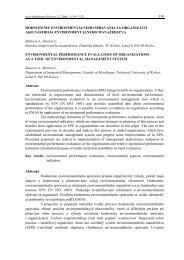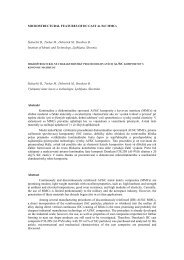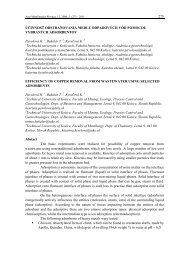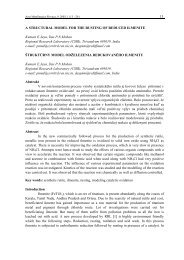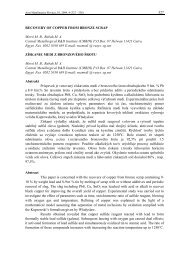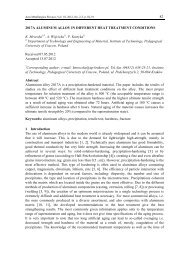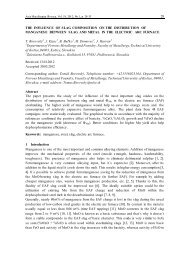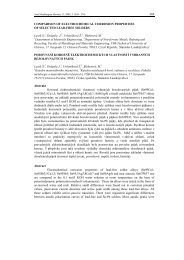IMPROVEMENTS OF HYDROMETA LURGICAL PROCESSES BY ...
IMPROVEMENTS OF HYDROMETA LURGICAL PROCESSES BY ...
IMPROVEMENTS OF HYDROMETA LURGICAL PROCESSES BY ...
You also want an ePaper? Increase the reach of your titles
YUMPU automatically turns print PDFs into web optimized ePapers that Google loves.
y acid retardation (example: CuSO 4 + H 2 SO 4 )The degree of separation also depends on the initial concentration of the free acid. In verydilute solutions, retardation becomes less distinct (Fig. 3), whereas acid retardation can be applied foracid solutions with a low metal content as well as for higher metal concentrations (Fig.4).Acid retardation has a wide range of application, because strong acids like hydrochloric acid,sulfuric acid, nitric acid and acid mixtures have been tested quite successfully.Fig.3 CuSO 4 -H 2 SO 4 -solutions with 20 g/l Cu 2+ and different concentrations of free acidFor phosphoric acid and hydrofluoric acid, the applicability has to be checked individually.The formation of metal complexes can have a detrimental effect on acid retardation, but in some casesthe separation can even be improved due to the very steep shape of the elution curves.Fig.4 Separation of a solution containing 42 g/l Ni 2+ , 3 g/l Cu 2+ , 15 g/l Zn 2+ , 7 g/l Fe 3+and 95 g/l free sulfuric acidOutline of technical equipmentsThe main part of an industrially used equipment for acid retardation is the column containingthe special ion exchange resin. For alternating feeding the column with the metal containing acid andwater as the eluant, dosing pumps as well as apportioning vessels can be used. The volumes of theliquids leaving the resin bed can be separately adjusted by independently operated valves to meet therequirements resulting from the eluation curves. In this way, different types of solutions can be treatedindividually to attain optimum results with regard to the concentration ratios of the materials to beseparated.An equipment with a capacity of about 300 liters per hour of acid metal salt solution ispresented in Fig.5.Fig.5 Equipment for regeneration of electrolytes for Al anodizing (GOEMAPUR Al100)-photo by courtesy of GOEMAThis appliance is operated automatically, and this type of column is a proven system, used inmany metal finishing plants for different processes.
Industrial applicationsIn the metal finishing industry, one main application of the acid retardation process is theregeneration of electrolytes for anodizing of aluminum. These solutions mostly consist of 150 to 275 gof sulfuric acid per liter but should not contain more than 10 g/l of aluminum, to maintain a highspecific conductivity and to guarantee oxide layers of optimum quality. As aluminum concentration ofmore than 2 g/l markedly decreases the conductivity, for an optimum current density a higher cellvoltage and a growing energy demand for cooling are necessary. Therefore, a continuous regenerationof electrolytes for anodizing of aluminum is an important process step for environmental protection.Moreover, savings for high purity sulfuric acid, alkali for neutralization, sludge disposal and energyhave been attained. That's why acid retardation is a very profitable procedure for every anodizing shop[3].Acid retardation has also been applied under technical conditions for the regeneration ofetchants, bright dips and pickling solutions. In all these cases, large amounts of free acids have beensaved, and the conditions for metal recovery, by which metal containing sludge can be avoided, havebeen improved.In order to make use of acid retardation in hydrometallurgy, investigations have been startedto find out optimum conditions for the removal of impurities and for acid recovery in zincelectrowinning as well as in copper refining plants. In every zinc tank house, large volumes ofelectrolytes have to be discarded for a constant concentration level of Mg and Mn. Many tests havebeen run to confirm that Mg and Mn can be easily removed from the electrolytes, thus returning themajor part of the sulfuric acid directly into the electrolyte conduit system (Fig.6). Zinc can be simplyrecovered from the Mg and Mn eluate by precipitation with a controlled pH (Fig.7).For the removal of As und Mi from electrolytes in copper refineries, laboratory-scale testshave indicated that several different portions of eluates can be collected separately to concentrate theimpurities under such conditions that they can be eliminated at the lowest possible expense (Fig.8).EconomyIn the Rear future, companies processing "hazardous materials" such as As, Cd, Cr, Cu, Ni,Pb, Zn etc., have to comply with new legislative rules for environmental protection, demanding the useof a new low-waste technology. Under these aspects, acid retardation can effectively contribute to theapplication of improved procedures, combined with low expenditure. Modest costs for investments,energy and labor, small floor space requirements and big savings for fresh acids, neutralizationchemicals, sludge disposal and lower metal losses guarantee that such an investment pays for itselfwithin a short period of time.Fig.6 Separation of H 2 SO 4 and the sulfates of Mg, Mn and Zn by acid retardation.201 g/l H 2 SO 4 ; 46.9 g/l Zn; 9.4 g/l Mn; 7.9 g/l Mg
Therefore in zinc electrowinning plants, bleeding off impurities in a conventional wayrequires the treatment of several ten m 3 of electrolyte per day, leading to large volumes of sludge andeverlasting environmental problems. Therefore, a rapid repay of the investment is obvious.The removal of As and Ni in copper refining can be performed in quite different ways. But apre-separation of As and Ni, returning part of the liquid directly into the tank house, and the treatmentof smaller volumes of bleeding electrolytes will certainly contribute to cost savings and will make iteasier to meet the environmental requirements.Fig.7 Precipitation of Zn 2+ as a hydroxide in the presence of Mg 2+ and Mn 2+ from fractions 6-15Fig.8 Separation of Cu 2+ , Ni 2+ and As 5+ from sulfuric acid by acid retardationFeeding solution: 9.5 g/l Cu 2+ , 30 g/l Ni 2+ , 21 g/l As 5+ and 430 g/l free H 2 SO 4SummaryAcid retardation is a proven procedure for the recovery of free acids from spent metal bearingsolutions. The process is based on different diffusion rates of metal ions and acids into a special ionexchange resin. For acid recovery, no chemicals are necessary. Therefore, this recovery technique cancontribute to meet the environmental requirements. The procedure has been made use of in metalfinishing already, but there are good chances for other applications, e.g. in hydrometallurgy.Literature[1] Hatch, M. J. and J. A. Dillon: Acid Retardation. Industrial and Engineering Chemistry 2 (1963) p.253-263[2] Lieber, H.-W.: Entwicklung emissionsarmer Technologien zur Gewinnung von NE-Metallen unterbesonderer Berücksichtigung der Hydrometallurgie. Forschungsbericht BMFT, Marz 1987, S. 154[3] Hartinger, L.: Lehr- und Handbuch der Abwassertechnik. S. 322, 370. Verlag Ernst & Sohn,Berlin, 1985



